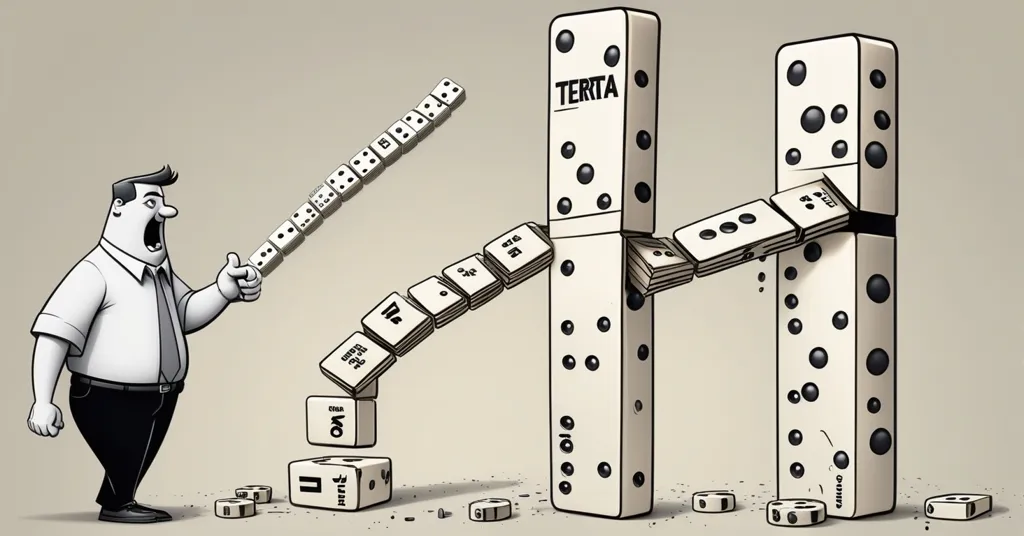Binance CEO CZ Unveils Insights on Terra and FTX Collapses in ‘Crypto Titans’

Binance CEO CZ Analyzes Terra and FTX Collapses in New Book ‘Crypto Titans’
In his new book, “Crypto Titans: The Rise and Fall of Digital Empires,” Binance CEO Changpeng Zhao (CZ) provides a detailed analysis of the events leading to the collapse of the blockchain platform Terra and the subsequent downfall of the cryptocurrency exchange FTX. The narrative begins with the May 2022 depegging of Terra’s algorithmic stablecoin UST, a type of stablecoin that uses algorithms to maintain its value, often pegged to the US dollar. This event triggered a domino effect that led to a liquidity crisis, a situation where an entity struggles to meet its short-term financial obligations, ultimately impacting FTX.
- Terra’s UST depegging in May 2022
- FTX’s liquidity crisis and collapse in November 2022
- CZ’s emphasis on risk management and regulatory environment
CZ describes the Terra collapse as the initial domino that fell, sparking a chain reaction across the crypto landscape. “The collapse of Terra was a domino that fell, triggering a chain reaction that no one could stop. FTX was just the next piece to topple,” he writes, highlighting the delicate balance within the interconnected web of the crypto ecosystem. This interconnectedness can be likened to a spider web where a break in one part affects the entire structure, illustrating the systemic risks inherent in the industry.
The book delves into how the liquidity crisis following UST’s failure led to the collapse of FTX in November 2022. CZ critiques the regulatory environment, arguing that the lack of effective regulation exacerbated the crisis. He emphasizes the need for a balanced approach that safeguards investors while fostering innovation within the decentralized finance (DeFi) space, which refers to financial services built on blockchain technology that operate without central intermediaries.
“Regulation, or the lack thereof, played a significant role in the unfolding of this crisis. We need a balanced approach that protects users without stifling innovation,” CZ states. This sentiment reflects the ongoing debate within the crypto community about the role of regulation in protecting users and ensuring the industry’s growth. While some advocate for stricter regulations, others argue that innovation could be stifled, leaving the crypto space in a precarious position.
“Crypto Titans” serves as a cautionary tale for the industry, highlighting both the potential and the pitfalls of decentralized finance. CZ’s insights into the operational and regulatory challenges faced by crypto businesses during this turbulent period provide valuable lessons for future endeavors. His emphasis on the need for better practices and oversight echoes the sentiments of many within the industry, who see the events of 2022 as a turning point for more responsible growth and development.
As the crypto community continues to navigate these challenges, CZ’s book offers a firsthand account from one of its most influential figures. It underscores the importance of understanding the systemic risks inherent in the interconnected web of the crypto ecosystem and calls for a collective effort to enhance risk management and regulatory frameworks. Can the crypto industry learn from these failures to build a stronger future? The narrative of Terra’s and FTX’s collapses is not just a story of failure but a roadmap for building a more resilient future in the world of digital currencies.
In the crypto world, it’s not about how you fall, but how you bounce back. CZ’s book emphasizes this resilience, advocating for the industry to learn from these events to ensure that the next chapter of its story is one of stability, innovation, and growth. While his perspective is clear, it’s important to consider alternative views on the causes of these collapses and the effectiveness of current regulatory frameworks. Some argue that different actions could have prevented these collapses, while others suggest that the regulatory environment is evolving to address these challenges.
From a Bitcoin maximalist perspective, these events highlight Bitcoin’s resilience and its role as a foundational cryptocurrency in a volatile market. Unlike algorithmic stablecoins like UST, Bitcoin’s decentralized nature and fixed supply make it less susceptible to the same kind of liquidity crises. However, it’s essential to recognize that altcoins and other blockchains, such as Ethereum, also play crucial roles in this financial revolution, filling niches that Bitcoin itself may not serve well.
The road ahead for the crypto industry involves continued innovation and growth. Emerging technologies and projects are learning from these failures, aiming to build more robust and resilient systems. As the industry evolves, so too will the regulatory landscape, with ongoing investigations and legal actions shaping the future of decentralized finance.
Key Takeaways and Questions
- What was the primary cause of Terra’s collapse according to CZ?
The primary cause was the depegging of UST, leading to a loss of confidence and a liquidity crisis.
- How did the collapse of Terra impact FTX?
It triggered a domino effect, causing liquidity issues at FTX and contributing to its bankruptcy.
- What role did regulation play in the crisis according to CZ?
The lack of effective regulation exacerbated the crisis, highlighting the need for a balanced regulatory approach.
- What lessons does CZ’s book offer for the crypto industry?
The importance of risk management, understanding the interconnectedness of the crypto ecosystem, and fostering innovation within a protective regulatory framework.
- Are there alternative views to CZ’s narrative on the collapses?
Yes, some argue that different actions could have prevented the collapses, and there are debates about the effectiveness of current regulatory frameworks.
- How might these events reinforce the importance of Bitcoin?
They highlight Bitcoin’s resilience and its role as a foundational cryptocurrency in a volatile market.



